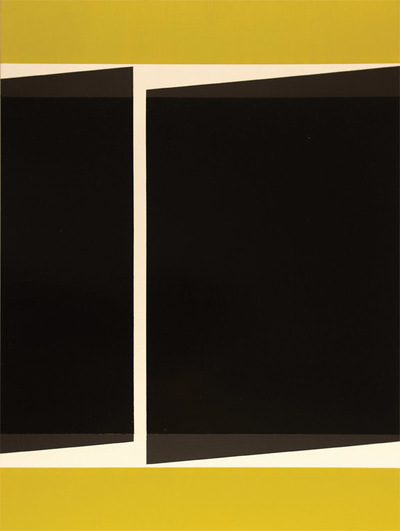DON VOISINE: NEW WORK
Edges are both something and nothing, defining space without sharing in it. This paradox is a constant in Don Voisine’s painting. He works his images into a variety of dimensions, yet it is in the nature of each of them to render scale irrelevant. As a group, they read as constantly shifting variations that could exchange measurements with each other at any moment. Given that instability, it would be better to ignore the instructions given by many of the titles, and simply walk through this exhibition inventing new ones for them.
The fantasies of geometry which are the subject of Stand In with its mock shadows and its shifting perspectives of inside and out suggest a Josef Albers unnerved and desperate. Whatever order is available in this particular world is an illusion, though an enthralling one. Perhaps these forms are simply the doors of perception, opened and closed by our looking.

Don Voisine, Leaf, 2013, oil on wood panel, 16 x 12″. Courtesy of the
artist and FRED.GIAMPIETRO Gallery.
Interlock, a painting of 2013, uses its tectonic plate formations as a device for allying Ad Reinhardt’s degrees of darkness with the formal splendor found in any one of Robert Motherwell’s Elegies to the Spanish Republic. Here the edge turns literal, with the triangle notches into the black shapes suggesting a double-edged razor blade that has been sterilized by fire.
There is a subtly rendered potential for disaster in Untitled, 2012, as if a road plan guaranteed to produce collisions at its intersections had been laid over a slightly canted city map, and now quietly awaits the crash of rush hour.
In the 2013 work Concord, a square of deeper darkness floats above a paler ground like some memorial to a future war awaiting its inscription, or a black hole in miniature that, within its compacted dimensions, creates a prison for all nearby light.
Pass is a work in which Voisine has managed the reduction of a landscape to an abstract purity that is still entirely convincing as an exercise in realism. Its grounding in the world, as it is, reads as both complete and astute. This is one of those pictures that make clear a painting is the only trustworthy way of seeing anything worthwhile at all.
